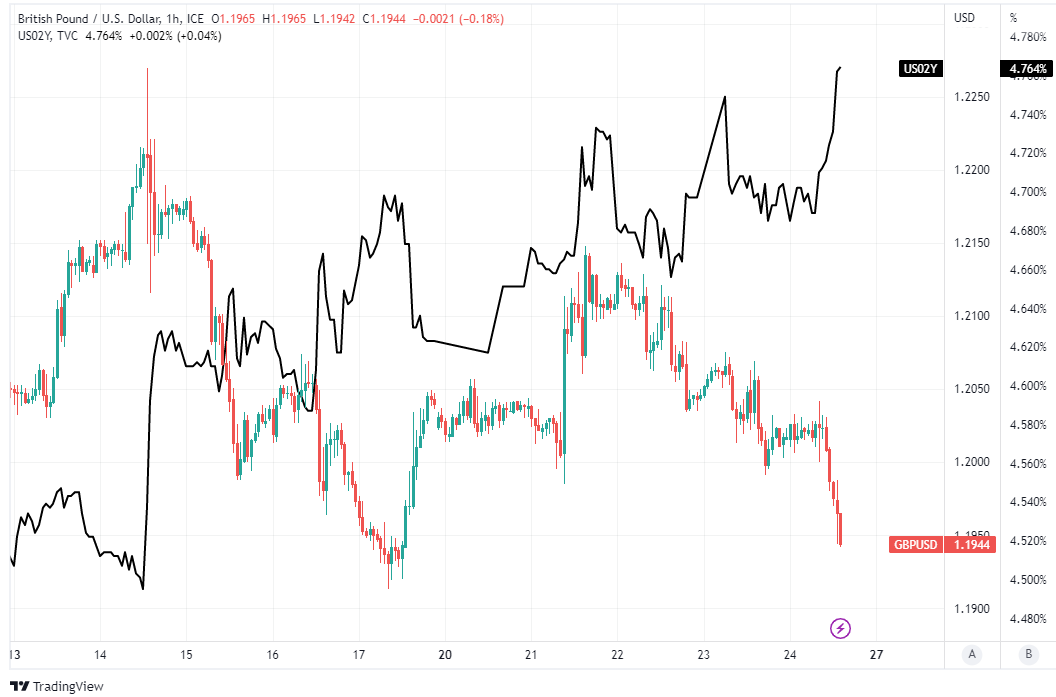GBP/USD Rate Tumbles into Key Levels On Charts after PCE Inflation Rises
- Written by: James Skinner
-
"That will add to concern for the Fed, especially in combination with still strong demand in discretionary consumption categories" - CIBC Capital Markets.

Image © Adobe Images
The Pound to Dollar exchange rate tumbled into key support levels on the charts in the final session of the week after the Federal Reserve's (Fed) preferred measure of inflation bounced notably in what might yet transpire to be a January harbinger of a renewed upturn.
Dollars were bought across the board on Friday with momentum picking up pace after the Bureau of Economic Analysis said the Core Personal Consumption Expenditures (PCE) Price Index inflation rate had risen by 0.6% in January, up from 0.4% previously.
Consensus had looked for an unchanged 0.4% reading but in the event price pressures strengthened enough to lift annual Core PCE inflation to 4.7%, from 4.6% previously, when economists had looked on average for a fall to 4.3%.
"That will add to concern for the Fed, especially in combination with still strong demand in discretionary consumption categories," says Katherine Judge, an economist at CIBC Capital Markets.

Most importantly for the Federal Reserve, the biggest drivers of the January inflation were in spending upon and prices of both non-durable goods and services - consumer items in other words - with the non-durable goods component having added the most to the upturn.
"Inflation is the symptom of imbalances resulting from years of monetary largesse and the supply and demand disruptions that followed the pandemic and the Russia-Ukraine war. Inflation since last year has necessitated a paradigm shift," says Chris Iggo, chair of AXA IM Investment Institute.
Wow! The odds of a 50 basis point hike in the #Fed Target Rate, instead of the signaled 25 bps, just spiked to almost 40%(!) after the higher-than-expected core #PCE #inflation.
— jeroen blokland (@jsblokland) February 24, 2023
The odds of a 6.0% Fed Target rate in July is now at almost 9%
😱 pic.twitter.com/jkDyCi7ECH
"As a result, any inflation release deviating from the idyllic path of a quick return to the pre-pandemic utopia of a global 2% rate means central bankers become more hawkish and the market prices in another notch higher in terminal interest rates," Iggo writes in response to the figures.
Friday's data will come as a disappointment to many on the Federal Open Market Committee who had voted in favour of February's step-down in the size of interest rate steps to 0.25% increments and hoped that a Fed Funds rate somewhere between 5% and 5.5% would be enough to see off inflation.
"Taken together, stronger inflation and a firmer message from policymakers should continue to keep upward pressure on the Dollar," says Isabella Rosenberg, an FX strategist at Goldman Sachs.
"Most of the recent declines in core PCE inflation have been driven by acyclical factors, while traditionally cyclical components of core PCE inflation remain elevated with relatively more modest signs of slowing," she adds.
The data disrupts a multi-month cooling that had been widely viewed and in some cases declared as the beginning of a disinflation process that would quickly take the Fed's favoured inflation measure back to its 2% target.
It's not yet clear what the data will mean for Fed policy but minutes of the February meeting revealed just this Wednesday that already back then some members of the Federal Open Market Committee had preferred to lift the Fed Funds rate by 0.5% earlier this month but settled on a smaller increase.

